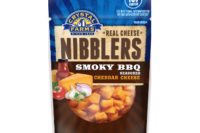Snacks used to be an occasional indulgence, but frequent snacking is now the norm. Data from Chicago-based market researcher IRI Group show that 49% of consumers reported eating one to two snacks per day, while another 43% reported eating three to four snacks daily. Today’s busy consumers often consume a portable snack in lieu of a traditional meal, especially at the morning occasion.
The $96 billion U.S. snack market is expected to grow by an additional 18% through 2020. The Innovation Center for U.S. Dairy has been conducting ongoing research to understand the opportunities for dairy in the snacking category. Lynn Stachura, senior vice president, strategy, insights and planning, at Dairy Management Inc., noted that the IC is currently focusing on understanding key consumer need-states.
Protein throughout the day
Data from the National Health and Nutrition Examination Survey 2007-2008 show that both breakfast and snacks are typically low in protein, with snacks providing roughly 24% of daily calories, but only 14% of daily intake of protein. As consumers increasingly view snacking as part of a healthy lifestyle, they continue to seek snacks with significant levels of protein. When consumed as part of a diet higher in protein, snacks with both whey and milk protein can help to improve satiety. Whey protein, as part of a reduced-calorie, higher-protein diet, may improve the quality of weight loss by helping people lose more fat and/or maintain more lean muscle.
In order to tout the benefits of protein in a snack food, food formulators should develop snacks with at least 5 grams of high-quality protein so they can make a “good source of protein” claim. Any reference to the protein content of a food, including front-of-pack descriptors, is considered a protein claim and triggers the need to list the protein percentage of daily value in the Nutrition Facts box.
Many grain-based foods have low protein quality, which can be improved by the addition of dairy protein. For example, wheat flour has a Protein Digestibility Corrected Amino Acid Score of 0.41, but the Savory Soft Pretzel with whey protein concentrate, developed by California Polytechnic State University, San Luis Obispo, for the IFT Food Expo, contains 9 grams of protein from a combination of wheat flour and WPC. Its PDCAAS is 1.00, which qualifies the pretzel for a protein claim.
Beverages and hand-held snacks
For many consumers, a speedy portable breakfast snack means a beverage. The NPD Group/Morning MealScape study revealed that 43% of consumers consume only a beverage at the morning occasion. At this year’s IFT Expo, the U. S. Dairy Export Council team combined two popular breakfast items — yogurt and coffee — in a Café Yogurt Frappe. An 8-ounce serving contains 10 grams of protein and the same amount of caffeine as a cup of coffee.
Three examples of foods that can double as both a speedy snack and a healthy breakfast were winners in this year’s Dairy Research Institute New Product Competition: Dairy Moofins (a muffin packed with dairy ingredients developed by Pennsylvania State University), DayBreakers (a milk protein-based concept similar to French toast developed by Iowa State University) and WheyGo (an egg, bacon and cheese scramble inside a crispy waffle crust, developed by The Ohio State University).
Snacks after exercise
After exercise is an ideal time to consume snacks with dairy protein. Examples include protein-based gels and chews. Research by Jeff Volek of the University of Connecticut indicates that consuming whey protein supplements resulted in greater gains in lean body mass compared with soy protein during a nine-month resistance training program. Volek’s research also indicated that consuming a fast-digesting protein like whey right after workouts provides both immediate and long-term benefits for protein synthesis.
To view formulas for all of the snack prototypes developed for this year’s Institute of Food Technologists Food Expo and supporting materials, visit http://www.innovatewithdairy.com/Pages/IFT2013.aspx.



